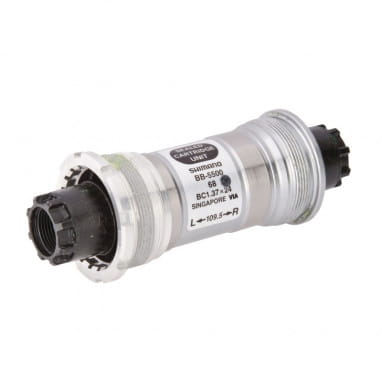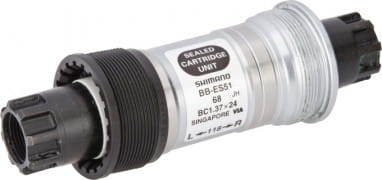In a multi-tooth inner bearing, the crankshaft is part of the bearing, the end of the shaft has several "teeth" that make efficient contact with the crank and can be driven with a lot of torque. The most popular multi-tooth systems are Octalink, ISIS and Powerspline. We have these bottom brackets for you in the store, but you can also find other, rarer copies here.
.
Vielzahn inner bearings replaced square inner bearings at the beginning of the 2000s, but in the meantime they themselves have been replaced by a more modern and above all lighter technology, the hollow axles. Nevertheless, they are still used on many older bikes, even on cheaper bikes or children's bikes they are still installed in large numbers. For this reason, you can buy multi-tooth bottom bracket here, and we explain how to find the right spare part for your bike.
In a multi-tooth bottom bracket, the crankshaft runs in a cartridge bearing, a completely sealed capsule. To the left and right, the crank is mounted.
With these bearings, by the way, the term "inner bearing" is correct, because the bearing is located inside a bottom bracket shell, the opening in the bike frame designed for it. In hollow axles, the actual bearings are located on the outside to the left and right of the frame; inner bearings are therefore not these components, "bottom bearing" would be more appropriate.
Why are multi-tooth bottom brackets better than square bottom brackets?
Four or many? Which is better? Quite simply, the more sides the bolt has, the better the contact and force distribution. So that you can pedal with more torque, therefore many sides are better than the four of a square system. You can think of it as similar to the difference between a slotted-head screwdriver and a Torx wrench. The larger contact surface allows Torx screws to be processed with significantly higher torque, and it behaves the same way at the bottom bracket. Incidentally, the front-runner is a "Power Spline" with a whole 12 sides.
Octalink
If you're looking for multi-tooth bottom brackets, you'll keep stumbling across the term Octalink. The Latin number octa ("eight") is the namesake of the octalink. Here, an octalink has a firm grip on the crank. The system was developed and built by Shimano.
There are now two different versions, Octalink V1 and Octalink V2. Attention. The corresponding components are not compatible!
ISIS
Not wanting to leave Shimano's octalink to corner the market completely on its own, a few manufacturers (including SRAM and subsidiary Truvativ) got together and launched a ten-sided system of their own called ISIS (International Spline Interface Standard).
How to find the right multi-tooth bottom bracket for your bike
.
Your bottom bracket makes unsightly noises with every turn of the crank? Since the bottom bracket is a wearing part, it must be replaced after a certain running time. Here is a pretty sure way to find a suitable replacement part.
Just grab your old bottom bracket, it says what size fits between your frame and your crank. You will find specifications such as the axle length and the housing diameter, so you are already quite a bit further (both you can also measure with a meter stick or a gauge). But so that the ordered spare part then really fits, you must also observe the thread standard. Often you read BSA or ITA, both are standards that describe the thread with which the bottom bracket is fixed in the frame in the bottom bracket shell.
You can select these values in our filters, then you will be shown the appropriate items.
A look at the article description can also help, here you will learn, among other things, whether an Octalink multi-tooth bottom bracket belongs to the V1 or V2 series. Much more information on buying the right bottom bracket can be found in our bearings.

